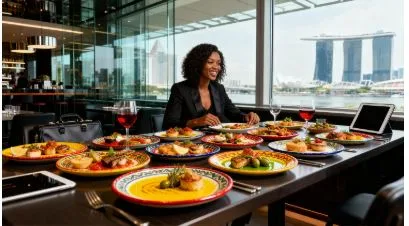Spanish Tapas Culture Transforms Singapore’s CBD Dining Scene in 2025
Singapore’s Central Business District has always been a melting pot of international cuisines, but 2025 is shaping up to be the year Spanish gastronomy truly claims its spotlight. From Raffles Place to Marina Bay, Spanish restaurants are drawing crowds who’ve grown tired of the same old lunch rotation.
I’ve watched this shift happen firsthand. Three years ago, suggesting Spanish food for a client lunch would’ve gotten you strange looks. Now? It’s become the sophisticated choice that signals you know your way around Singapore’s dining scene.
Why Spanish Food is Having Its Moment
The timing makes sense when you think about it. Singapore’s diners have become incredibly sophisticated. We’ve done Italian to death, explored every corner of Japanese cuisine, and French dining has been here forever. Spanish food offers something different whilst still feeling premium enough for business occasions.
What really caught on is the tapas concept. In a city where everyone’s perpetually busy, the idea of ordering five small dishes instead of committing to one massive entrée just works. You get variety without the food coma that derails your afternoon productivity.
Last week, I had lunch with a property developer at a Spanish place near One Raffles Quay. We ordered maybe seven different tapas between us. Patatas bravas, some Padrón peppers, grilled octopus, Ibérico ham. The conversation flowed naturally because we kept discovering new flavours together. Try getting that dynamic with two separate steaks.
The Wine Factor Nobody’s Talking About
Here’s something interesting that doesn’t get enough attention: Spanish wines are seriously undervalued compared to French or Italian bottles. I’ve seen restaurants in the CBD offering exceptional Riojas and Ribera del Dueros at prices that would barely get you a decent Bordeaux elsewhere.
According to Wine Spectator’s recent tastings, Spanish wine regions have been quietly producing world-class vintages whilst everyone else was focused on Burgundy and Napa. The quality-to-price ratio is remarkable, which matters tremendously for businesses watching their dining budgets.
A colleague of mine just closed a partnership deal over a bottle of Tempranillo that cost less than what she usually spends on lunch wine. The client specifically mentioned how impressed they were with the selection. Small details like that stick with people.
What Makes Spanish Dining Work for Business
The whole atmosphere is different from typical business restaurants. Spanish dining culture emphasises lingering over meals, having actual conversations, building genuine relationships. That’s exactly what business lunches should be about, but somehow we’ve turned them into efficiency exercises where everyone’s checking their phones between courses.
Spanish restaurants tend to understand this balance. The service is attentive without being intrusive. The music creates energy without overwhelming conversation. The food arrives at a pace that encourages discussion rather than rushing.
I’ve noticed that younger entrepreneurs particularly gravitate towards Spanish spots. Maybe it’s because the format feels less stuffy than traditional business dining. You’re not performing elaborate knife-and-fork choreography with a massive piece of meat. You’re just sharing good food with people you’re trying to work with.
The Authenticity Question
Not every place calling itself Spanish actually delivers authentic food. I’ve been to enough disappointing “tapas bars” serving frozen croquettes and calling it a day. What separates the real Spanish restaurants from the pretenders comes down to details: proper Spanish ingredients, cooking techniques that respect tradition, staff who actually understand what they’re serving.
The best Spanish establishments in Singapore take their food seriously. They’re importing quality products from Spain, using traditional preparation methods, maintaining wine lists that showcase different Spanish regions properly. Places like Vino Tinto Spanish Tapas & Bar exemplify this commitment to authenticity whilst adapting to Singapore’s business dining context.
When you walk into a proper Spanish restaurant, you should smell garlic hitting hot olive oil. You should see actual saffron in the paella, not just yellow rice. The Manchego cheese should taste like it came from La Mancha, not some generic substitute.
Health-Conscious Without Being Boring
Another factor driving Spanish food’s popularity is how it fits modern dietary preferences without making a fuss about it. The Mediterranean diet has been recognised by UNESCO as Intangible Cultural Heritage partly because of its health benefits.
Spanish cooking naturally emphasises olive oil instead of butter, plenty of vegetables, lean proteins, moderate portions. You’re eating well without feeling like you’ve ordered from some restrictive diet menu. Nobody wants to be that person at a business lunch picking sadly at a plain grilled chicken breast.
I’ve got a friend who’s vegetarian and she actually prefers Spanish restaurants now because the vegetable dishes are genuinely exciting. Grilled asparagus with romesco sauce, Padrón peppers with sea salt, mushroom croquettes. These aren’t afterthought menu items; they’re dishes people actively want to order.
The Social Media Effect
Let’s be honest: Instagram has played a role in Spanish food’s popularity. A perfectly composed paella arriving at your table makes for a much better photo than most other cuisines. The vibrant colours, the dramatic presentation, the sharing aspect that encourages multiple people in the shot.
I’m not saying people are choosing restaurants purely for social media, but it doesn’t hurt when your business lunch looks impressive online. I’ve seen junior staff get genuinely excited about Spanish restaurant bookings because they know the food will photograph well.
The whole visual aspect of Spanish dining works in professional contexts too. When you’re hosting international clients, serving them a stunning seafood paella creates a memorable experience. They’re not just getting fed; they’re getting an experience they’ll remember and probably tell colleagues about.
What This Means for Singapore’s Dining Scene
The Spanish dining trend represents something larger about how Singapore’s food culture is maturing. We’re moving past the phase where any international cuisine automatically impressed people. Now, diners want authenticity, quality, and experiences that feel distinctive.
Spanish restaurants are filling a specific niche: sophisticated enough for business dining, relaxed enough for genuine connection, interesting enough to feel special without being intimidating. That’s a difficult balance to strike, and the Spanish dining format achieves it naturally.
I’ve been tracking restaurant openings in the CBD, and Spanish concepts keep popping up. Not all will survive, of course. Singapore’s restaurant scene is ruthlessly competitive. But the ones that understand what they’re doing, that respect Spanish culinary traditions whilst serving Singapore’s business community, those places are thriving.
Looking Forward
Will Spanish food maintain this momentum? Probably. Unlike some dining trends that burn bright and fade quickly, Spanish cuisine has enough depth and variety to sustain long-term interest. Spain’s regions offer dramatically different cooking styles. You could eat Spanish food for months without repeating the same experience.
For business dining specifically, Spanish restaurants have proven they understand the assignment. They’re creating environments where deals happen, relationships develop, and people actually enjoy their meals instead of just tolerating them between meetings.
Next time you’re setting up a business lunch and cycling through the same old options, consider going Spanish. Order too many tapas, share a decent bottle of Rioja, and actually talk to whoever you’re dining with. You might find that slowing down occasionally produces better results than rushing through another forgettable meal.
The Spanish figured this out centuries ago: good food and good wine make everything work better, including business. Singapore’s finally catching on.




